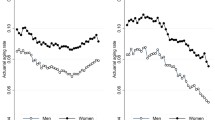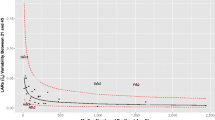All rules of decent behavior have been known for ages; the problem is to learn how to use them.
Blaise Pascal (1623–1662)
Abstract
Analysis of demographic data on human mortality and lifespan carried out according to the complete Gompertz-Makeham model μ = C + λeγxt shows that, over the last 100 years, the life expectancy increased almost exclusively because the Makeham parameter C decreased. The observed changes in the demographic aging rate γ and in the initial vitality, which is inversely proportional to lnλ, may be largely an artifact of the attempts to decompose mortality data related to conditions that significantly change within a time scale comparable to the human lifespan, whereas the correct decomposition of mortality change by different Gompertz-Makeham parameters is possible only for a strictly homogeneous population under strictly stationary conditions. What actually remains of changes in these parameters, while theoretically significant, would probably be negligible in the quantitative practical aspect. The comparison of this situation with experiments on animals, suggesting possible interferences that may decrease the aging rate and/or increase the lifespan, reveals that the main factors of reduced mortality and, correspondingly, increased lifespan in human beings are limited to one’s personal commitment to following long-standing and readily available guidelines for healthy life, which may help bring one’s lifespan about 10 years closer to the reliably recorded maximum of 122 years, although they obviously do not guarantee it. The bottleneck for the realization of this reserve resides in public and individual mentality rather than in science.
Similar content being viewed by others
References
Anisimov, V.N., Means of Prevention of Premature Aging (Geroprotectors), Usp. Gerontol., 2000, no. 4, pp. 55–73.
Golubev, A.G., Catecholamines, Steroids, and Aging of the Nervous and Endocrinal Systems, Usp. Sovrem. Biol., 1989, no. 6, pp. 64–75.
Golubev, A.G., Alzheimer’s Disease, Amiloidoses, and Aging, Usp. Gerontol., 2000, no. 4, pp. 102–112.
Golubev, A.G., Biochemistry of Life Prolongation, Usp. Gerontol., 2003, no. 12, pp. 57–76.
Golubev, A. How Could the Gompertz-Makeham Law Evolve? J. Theor. Biol., 2009, vol. 258, pp. 1–17.
Golubev, A.G., The Issue of Feasibility of a General Theory of Aging: II. Parametabolic Theory of Aging, Usp. Gerontol., 2009, no. 2, pp. 205–222.
Alley, D., Suthers, K., and Crimmins, E., Education and Cognitive Decline in Older Americans: Results from the AHEAD Sample, Res. Aging, 2007, vol. 29, pp. 73–94.
Allison, D.B., Miller, R.A., Austad, S.N., et al., et al., Genetic Variability in Responses to Caloric Restriction in Animals and in Regulation of Metabolism and Obesity in Humans, J. Geront. Ser. A, 2001, vol. 56A, pp. 55–65.
Ang, L.S., Cruz, R.P., Hendel, A., and Granville, D.J., Apolipoprotein E, an Important Player in Longevity and Age-Related Diseases, Exp. Gerontol., 2008.
Bjelakovic, G., Nikolova, D., Gluud, L.L., et al., et al., Mortality in Randomized Trials of Antioxidant Supplements for Primary and Secondary Prevention: Systematic Review and Meta-Analysis, J.A.M.A., 2007, vol. 297, pp. 842–857.
de Gray, A.D., The Foreseeability of Real Antiaging Medicine: Focusing the Debate, Exp. Gerontol., 2003, vol. 38, pp. 927–934.
de la Fuente-Fernandez, R., Impact of Neuroprotection on Incidence of Alzheimer’s Disease, PLoS ONE, 2006, vol. e52. doi: 10.1371/journal.pone.0000052.
Deary, I., Why Do Intelligent People Live Longer?, Nature, 2008, vol. 456, pp. 175–176.
Feinleib, M., Epidemiology of Obesity in Relation to Health Hazards, Ann. Int. Med., 1985, vol. 103, pp. 1019–1024.
Fraser, G.E. and Shavlik, D.J., Ten Years of Life: Is It a Matter of Choice?, Arch. Int. Med., 2001, vol. 161, pp. 1645–1652.
Hanson, R.W. and Hakimi, P., Born to Run: The Story of the PEPCK-Cmus Mouse, Biochimie, 2008, vol. 90, pp. 838–842.
Harris, B., Growing Taller, Living Longer? Anthropometric History and the Future of Old Age, Aging and Society, 1997, vol. 17, pp. 491–512.
Holliday, R., Human Ageing and the Origins of Religion, Biogerontology, 2001, vol. 2, pp. 73–77.
Holloszy, J.O., Longevity of Exercising Male Rats: Effect of an Antioxidant Supplemented Diet, Mech. Aging Dev., 1998, vol. 100, pp. 211–219.
Holloszy, J.O. and Fontana, L., Caloric Restriction in Humans, Exp. Gerontol., 2007, vol. 42, pp. 709–712.
Hotamisligil, G.S., Inflammation and Metabolic Disorders, Nature, 2006, vol. 444, pp. 860–867.
Huang, H.Y., Helzlsouer, K.J., and Appel, L.J., The Effects of Vitamin C and Vitamin E on Oxidative DNA Damage: Results from a Randomized Controlled Trial, Cancer Epidem. Biomarkers Prev., 2000, vol. 9, pp. 647–652.
Khazaeli, A.A., Van Voorhies, W., and Curtsinger, J.W., The Relationship between Life Span and Adult Body Size Is Highly Strain-Specific in Drosophila melanogaster, Exp. Geront., 2005, vol. 40, pp. 377–385.
Kopp, M.S., Skrabski, A.D., Szekely, A., et al., et al., Socioeconomic Determination of Chronic Stress, Ann. N.Y. Acad. Sci, 2007, vol. 1113, pp. 325–338.
la Cour, P., Avlund, K., and Schultz-Larsen, K., Religion and Survival in a Secular Group: A Twenty Year Follow-up of 734 Danish Adults Born in 1914, Soc. Sci. Med., 2006, vol. 62, pp. 167–164.
Lange-Asschenfeldt, C. and Kojda, G., Alzheimer’s Disease, Cerebrovascular Dysfunction and the Benefits of Exercise: From Vessels to Neurons, Exp. Geront., 2008, vol. 43, pp. 499–504.
Markham, J.A. and Greenough, W.T., Experience-Driven Brain Plasticity: Beyond the Synapse, Neuron Glia Biol., 2004, vol. 1, pp. 351–363.
Marmot, M.G., Alcohol and Coronary Heart Disease, Int. J. Epidem., 2001, vol. 30, pp. 724–729.
McTiernan, A., Ulrich, C., Slate, S., and Potter, J., Physical Activity and Cancer Etiology: Associations and Mechanisms, Cancer Causes Control, 1998, vol. 9, pp. 487–509.
Mehlman, M.J., Binstock, R.H., Juengst, E.T., et al.,et al., Anti-Aging Medicine: Can Consumers Be Better Protected?, The Gerontologist, 2004, vol. 44, pp. 304–310.
Oeppen, J., Life Expectancy Convergence Among Nations since 1820: Separating the Effects of Technology and Income, Perspectives on Mortality Forecasting. III. The Linear Rise in Life Expectancy: History and Prospects, Social Insurance Studies, Bengtsson, T., Ed., Swedish Social Insurance Agency, 2006, no. 3., pp. 55–83.
Paffenbarger, R.S., Hyde, R.T., Wing, A.L., et al., The Association of Changes in Physical-Activity Level and Other Lifestyle Characteristics with Mortality among Men, N. Engl. J. Med., 1993, vol. 328, pp. 538–545.
Pedersen, J.Ø., Heitmann B. L., Schnohr P, Grønbøk M., The Combined Influence of Leisure-Time Physical Activity and Weekly Alcohol Intake on Fatal Ischaemic Heart Disease and All-Cause Mortality, Eur. Heart J., 2008, vol. 29, pp. 1–9.
Phelan, J.P. and Rose, M.R., Why Dietary Restriction Substantially Increases Longevity in Animal Models but Won’t in Humans, Aging Res. Rev., 2005, vol. 4, pp. 339–350.
Prencipe, M., Casini, A.R., Ferretti, C., et al.,et al., Prevalence of Dementia in an Elderly Rural Population: Effects of Age, Sex, and Education, J. Neurol. Neurosurg. Psychiat., 1996, vol. 60, pp. 628–633.
Riley, K.P., Snowdon, D.A., Desrosiers, M.F., and Markesbery, W.R., Early Life Linguistic Ability, Late Life Cognitive Function, and Neuropathology: Findings from the Nun Study, Neurobiol. Aging, 2005, vol. 26, pp. 341–347.
Samaras, T.T., Should We Be Concerned over Increasing Body Height and Weight?, Exp. Gerontol., 2009, vol. 44, pp. 83–92.
Sherwin, C.M., Voluntary Wheel Running: A Review and Novel Interpretation, Animal Behav., 1998, vol. 56, pp. 11–27.
Shkolnikov, V.M., Andreev, E.M., Leon, D.A., et al., Mortality Reversal in Russia: The Story so Far, Hygiea Int., 2004, vol. 4, pp. 29–80.
Thompson, L.V., Age-Related Muscle Dysfunction, Exp. Geront., 2008, doi: 10.1016/j.exger.2008.05.003.
Thune, I. and Furberg, A.S., Physical Activity and Cancer Risk: Dose-Response and Cancer, All Sites and Site-Specific, Med. Sci. Sports Exerc., 2001, vol. 33, pp. 530–550.
Wachter, K.W., Hazard Curves and Life Span Prospects, Pop. Dev. Rev., 2003, vol. 29.Suppl.: Life Span: Evolutionary, Ecological, and Demographic Perspectives, pp. 270–291.
Wilmoth, J.R. and Robine, J.-M., The World Trend in Maximum Life Span, Popul. Dev. Rev., 2003, vol. 29.
Wilmoth, J.R., Deegan, L.J., Lundstrom, H., and Horiuchi, S., Increase of Maximum Life-Span in Sweden, 1861–1999, Science, 2000, vol. 289, pp. 2366–2368.
Wolkow, C.A., Identifying Factors that Promote Functional Aging in Caenorhabditis elegans, Exp. Geront., 2006, vol. 41, pp. 1001–1006.
Author information
Authors and Affiliations
Corresponding author
Additional information
Original Russian Text © A. G. Golubev, 2009, published in Uspekhi Gerontologii, 2009, Vol. 22, No. 3, pp. 387–400.
Rights and permissions
About this article
Cite this article
Golubev, A.G. The issue of the feasibility of a general theory of aging. III. Theory and practice of aging. Adv Gerontol 2, 109–119 (2012). https://doi.org/10.1134/S207905701206001X
Received:
Published:
Issue Date:
DOI: https://doi.org/10.1134/S207905701206001X




